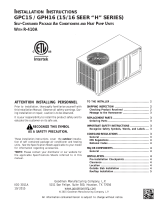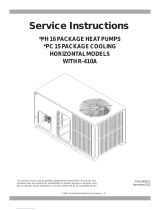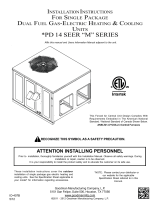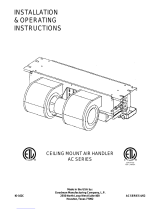
9
6. Defrost Control - The Defrost control provides time/
temperature initiation and termination of the defrost cycle.
When a Defrost cycle is initiated, the defrost control shifts
the reversing valve to “cooling” mode, stops the outdoor
fan and brings on supplemental heat. Normally, a Defrost
cycle will take only 2-3 minutes unless system is low on
charge or outdoor conditions are severe. (Windy and cold.)
The defrost control also provides for a 3 minute off cycle
compressor delay.
7. Outdoor Thermostat - These optional controls are used to
prevent full electric heater operation at varying outdoor
ambient (0° F-to 45° F). They are normally open above their
set points and closed below to permit staging of indoor
supplement heater operation. If the outdoor ambient
temperature is below 0° F (-18° C) with 50% or higher RH,
an outdoor thermostat (OT) must be installed and set at
(0°) on the dial. Failure to comply with this requirement
may result in damage to the product which may not be
covered by the manufacturer’s warranty.
8. Reversing Valve Coil - This coil is activated by the
thermostat, in the cooling mode and during defrost. It
positions the reversing valve pilot valve for cooling
operation.
9. Indoor Blower Motor
Units with EEM Motors The EEM model indoor blower motor
is activated by the room thermostat by COOLING/HEATING
or FAN ON position. The motor is energized by a 24 volt
control signal (from thermostat Y, G or W) for EEM motors.
EEM motors are constant torque motors with very low power
consumption.
(See Air Flow Measurement and Adjustment for speed
adjustment instructions).
10. Blower Interlock Relay - This relay is used to energize the
blower during the electric heat operation. Some room
thermostats do not energize the motor during electric heat.
This relay insures blower operation when the room
thermostat energizes heat. This relay has a 240 volt coil
and an 8 amp contact relay. This relay is energized by the
electric heat kit sequencer.
EXPLANATION AND GUIDANCE (HEAT PUMP)
The heat pump is a relatively simple device. It operates exactly
as a Summer Air Conditioner unit when it is on the cooling
cycle. Therefore, all the charts and data for service that apply
to summer air conditioning apply to the heat pump when it
is on the cooling cycle, and most apply on the heating cycle
except that “condenser” becomes “evaporator”, “evaporator”
becomes “condenser”, “cooling” becomes “heating”.
When the heat pump is on the heating cycle, it is necessary
to redirect the refrigerant flow through the refrigerant circuit
external to the compressor. This is accomplished with a
reversing valve. Thus, the hot discharge vapor from the
compressor is directed to the indoor coil (evaporator on the
cooling cycle) where the heat is removed, and the vapor
condenses to liquid. It then goes through the expansion
device to the outdoor coil (condenser on the cooling cycle)
where the liquid is evaporated, and the vapor goes to the
compressor.
When the solenoid valve coil is operated either from heating to
cooling or vice versa, the piston in the reversing valve to the
low pressure (high pressure) reverse positions in the reversing
valve.
Figure 7 shows a schematic of a heat pump on the cooling
cycle and the heating cycle. In addition to a reversing valve,
a heat pump is equipped with an expansion device and check
valve for the indoor coil, and similar equipment for the outdoor
coil. It is also provided with a defrost control system.
The expansion devices are flowrator distributors and perform
the same function on the heating cycle as on the cooling
cycle. The flowrator distributors also act as check valves
to allow for the reverse of refrigerant flow.
When the heat pump is on the heating cycle, the outdoor
coil is functioning as an evaporator. The temperature of the
refrigerant in the outdoor coil must be below the temperature
of the outdoor air in order to extract heat from the air. Thus,
the greater the difference in the outdoor temperature and
the outdoor coil temperature, the greater the heating capacity
of the heat pump. This phenomenon is a characteristic of a
heat pump. It is a good practice to provide supplementary
heat for all heat pump installations in areas where the
temperature drops below 45° F. It is also a good practice to
provide sufficient supplementary heat to handle the entire
heating requirement should there be a component failure of
the heat pump, such as a compressor, or refrigerant leak,
etc.
Since the temperature of the liquid refrigerant in the outdoor
coil on the heating cycle is generally below freezing point,
frost forms on the surfaces of the outdoor coil under certain
weather conditions of temperature and relative humidity.
Therefore, it is necessary to reverse the flow of the refrigerant
to provide hot gas in the outdoor coil to melt the frost
accumulation. This is accomplished by reversing the heat
pump to the cooling cycle. At the same time, the outdoor
fan stops to hasten the temperature rise of the outdoor coil
and lessen the time required for defrosting. The indoor blower
continues to run and the supplementary heaters are
energized. DEFROST CONTROL
During operation the power to the circuit board is controlled
by a temperature sensor, which is clamped to a feeder tube
entering the outdoor coil. Defrost timing periods of 30,60
and 90 minutes may be selected by setting the circuit board
jumper to 30, 60 and 90 respectively. Accumulation of time
for the timing period selected starts when the sensor closes
(approximately 34 + 5° F), and when the wall thermostat
calls for heat. At the end of the timing period, the unit’s
defrost cycle will be initiated provided the sensor remains
closed. When the sensor opens (approximately 60° F), the
defrost cycle is terminated and the timing period is reset. If
the defrost cycle is not terminated due to the sensor
temperature, a twelve minute override interrupts the unit’s
defrost period.
























